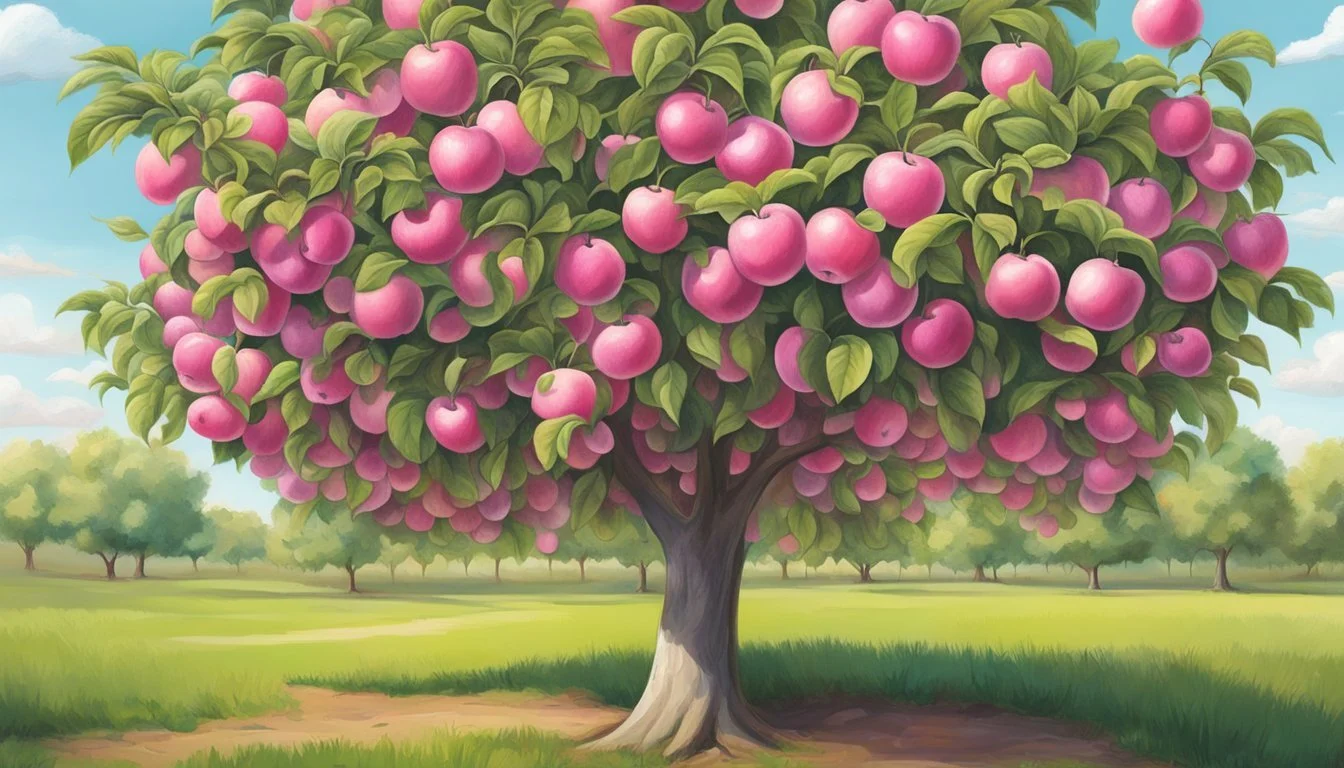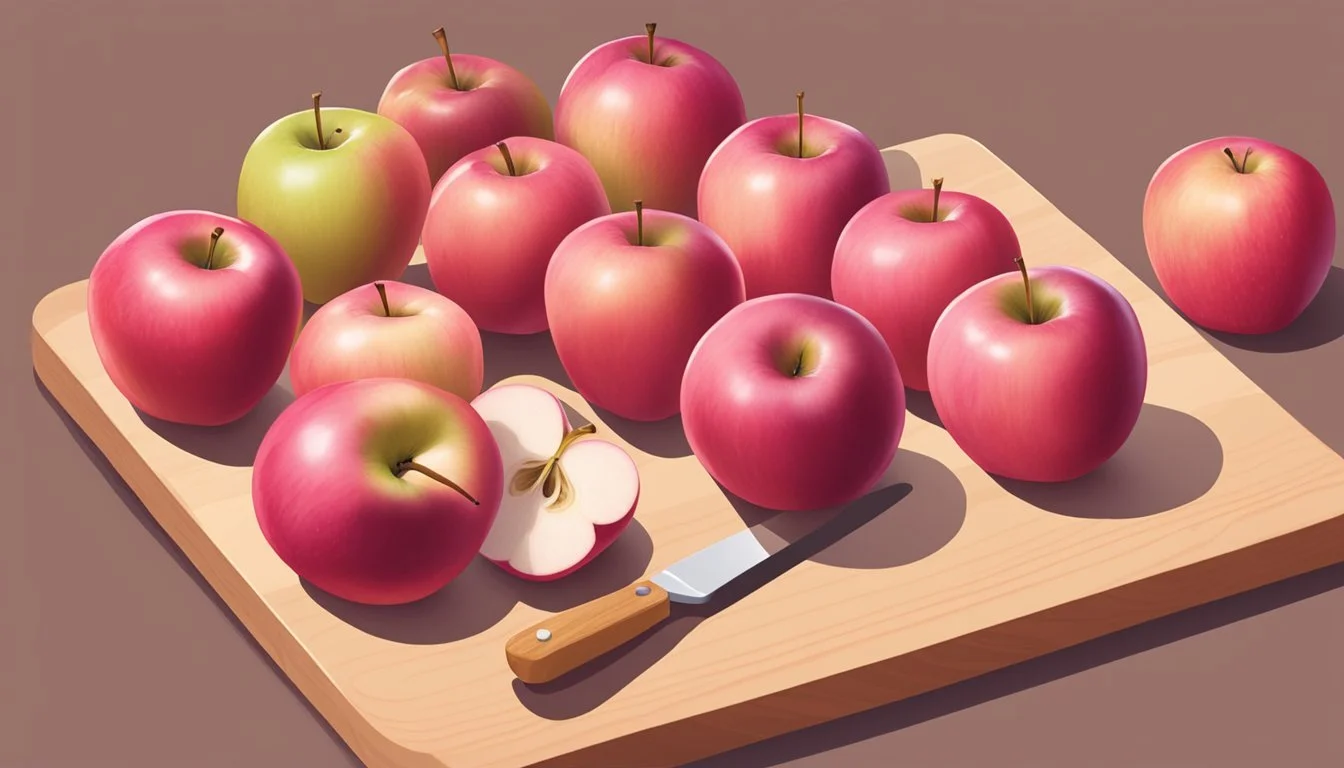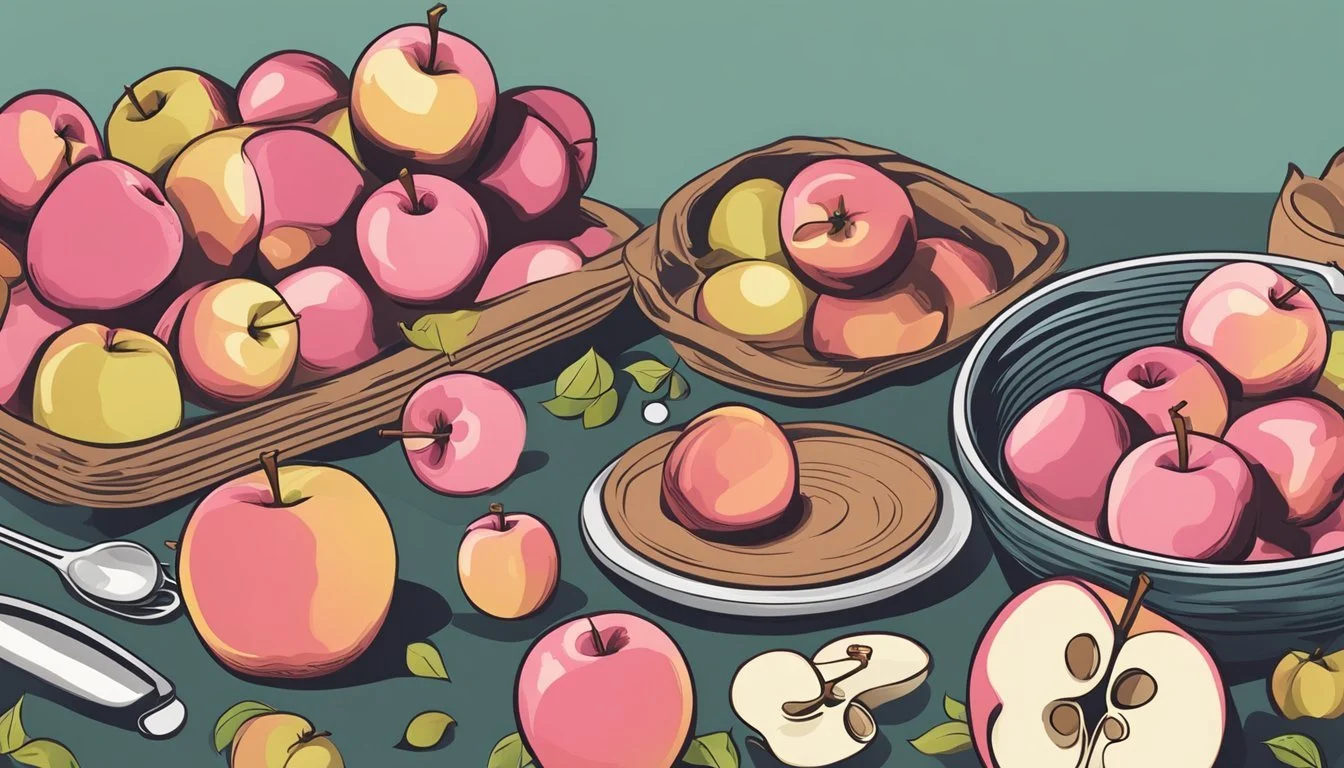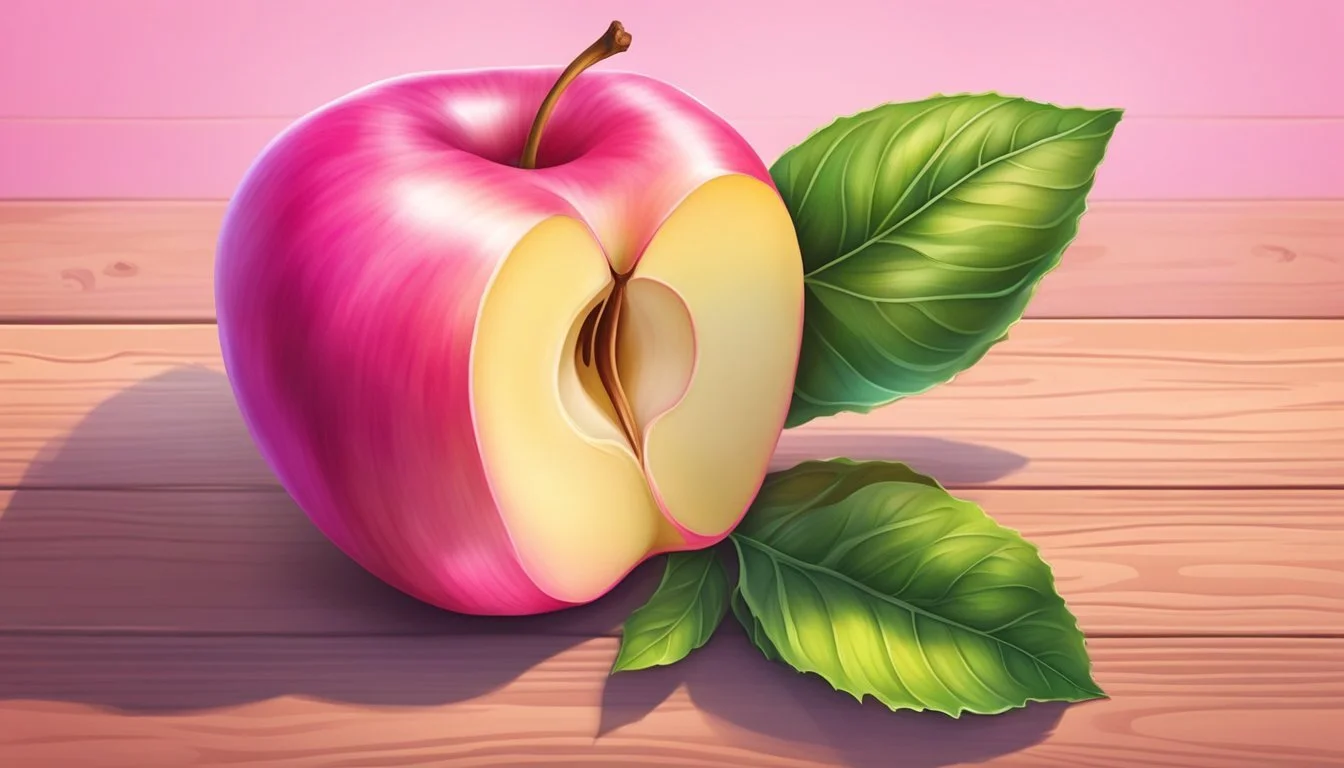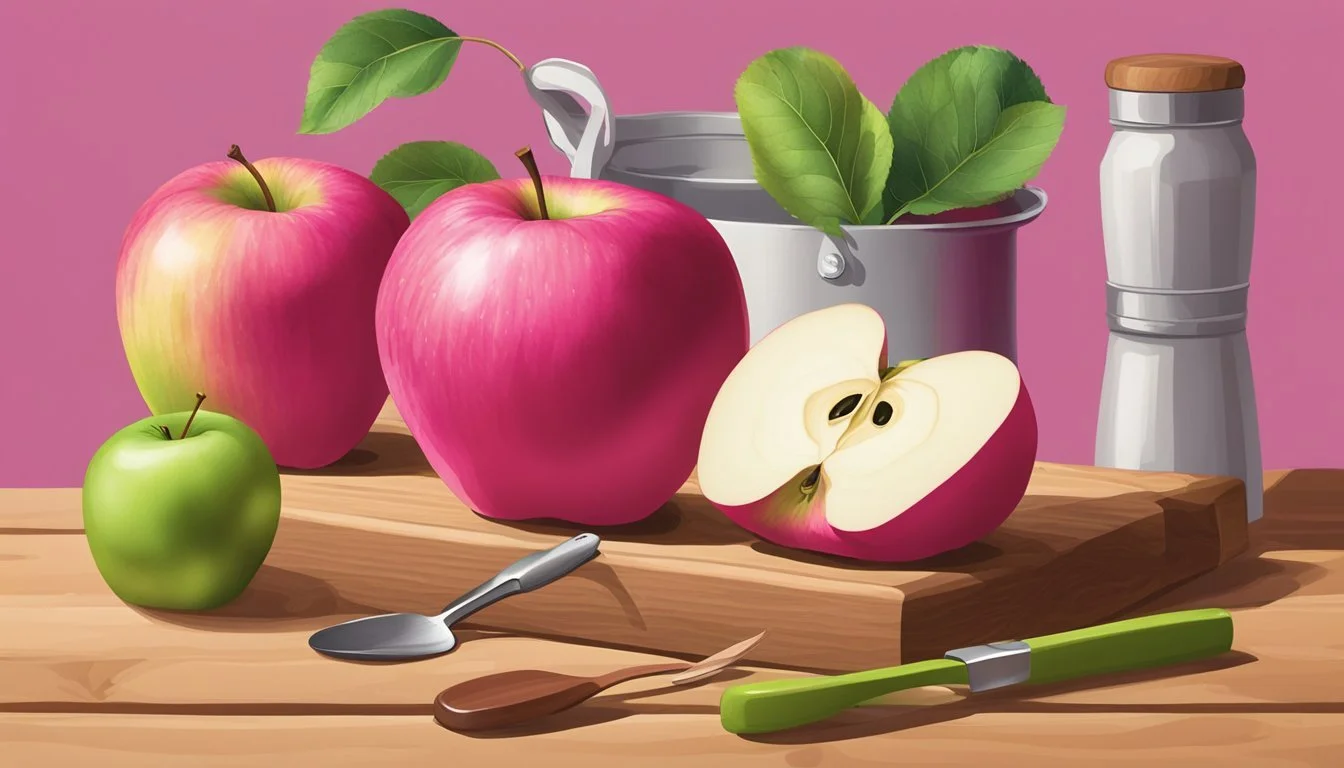How to Tell if a Pink Lady Apple is Ripe
Your Ultimate Guide to Perfectly Timed Enjoyment
Determining when a Pink Lady apple is ripe combines sensory cues with an understanding of the fruit's unique characteristics. Pink Lady apples, known for their balanced sweet-tart flavor profile and distinguishable pink blush over yellow or green skin, reach peak ripeness at specific times which are crucial for the best eating experience. Recognizing ripeness involves assessing color, feel, and aroma, all of which signal that the apple is ready to be enjoyed.
When examining Pink Lady apples, the ideal ripeness is indicated by a bright, vivid pink hue on the skin and a fruit that is firm to the touch with a slightly yielding surface. The aromatics of ripe Pink Lady apples are often described as having a delicate blend of floral, vanilla, and rose, accompanied by a juicy crispness that further enhances its desirability. With proper storage and handling, the ripeness of these apples can be maintained, ensuring that their nutritional value and unique flavor profile are preserved for consumption, whether fresh or used in culinary preparations.
Key Takeaways
Ripe Pink Lady apples are characterized by a vibrant pink skin, firm texture, and aromatic scent.
Proper assessment and care can preserve the apple's nutritional benefits and exceptional flavor.
Pink Lady apples maintain their quality in both raw and cooked culinary applications.
Identifying Pink Lady Apples
When selecting Pink Lady apples, it is essential to recognize their unique features and understand the difference between Pink Lady and Cripps Pink varieties to ensure the authenticity and ripeness of the fruit.
Characteristics of Pink Lady Apples
Pink Lady® apples, a distinct variety of Malus domestica, are celebrated for their striking appearance and balance of sweet and tart flavors. They possess a distinctive pink blush over a yellow or green base. Typically, these apples are:
Medium to large in size.
Conical in shape.
Encased in a thin skin.
Inside, the fine-grained flesh is both crisp and crunchy, offering a delectable sweetness with a hint of tartness. When ripe, these apples maintain their signature coloring and firmness. In fact, proper exposure to strong sunlight is crucial for their pink coloration to fully develop.
Pink Lady and Cripps Pink: Understanding the Difference
Although often confused, "Pink Lady" is actually a brand name used under license by growers who meet the specific quality standards of the trademark. On the other hand, "Cripps Pink" refers to the variety itself, from which Pink Lady® apples are selected. The distinction lies in the following points:
Pink Lady® apple is the trademarked name given to top-grade Cripps Pink apples.
Only those Cripps Pink apples that meet high-quality standards regarding sugar, acid content, and firmness are marketed as Pink Lady®.
Meticulous growers uphold these standards to maintain the integrity of the Pink Lady brand, assuring that every apple reaching the market under this name satisfies consumers' expectations for quality and taste.
Optimal Growing Conditions for Pink Lady Apples
Selecting the right growing conditions for Pink Lady apple trees is crucial to ensure a bountiful harvest. These trees require specific climate and soil parameters to produce their distinctive and flavorful fruit.
Climate and Sunlight Requirements
Pink Lady apple trees thrive in mild, temperate climates and need a long growing season. They are best suited for regions where the growing season spans several months, allowing the fruit ample time to develop its signature sweet-tart flavor. Growers in the southern hemisphere often favor Pink Lady apples due to their favorable conditions. For optimal growth, these apple trees should receive full sun, which means at least six hours of direct sunlight each day. Sunlight is essential for the trees throughout their growing season, influencing the quality and quantity of the fruit produced.
Soil Type and Nutrition
The ideal soil type for Pink Lady apple trees is one that is well-draining, yet retains adequate moisture. A slight preference toward slightly acidic soil with a pH range between 6.0 to 6.5 should be targeted. If a soil test indicates an imbalance in pH, growers can adjust it by adding lime to increase the pH or sulfur to decrease it. Beyond pH, the soil must be rich in nutrients, as the trees are heavy feeders. Essential nutrients, which are key to the trees' health and productivity, should be maintained through regular fertilization and soil management practices. Furthermore, soils with a good mix of loam and sand are beneficial to promote proper root growth and water drainage.
When to Harvest Pink Lady Apples
Determining the right time to harvest Pink Lady apples is crucial for achieving the perfect balance of sweetness and tartness. The key to picking Pink Lady apples at the peak of ripeness lies in understanding the signs of maturity while also being aware of the general harvest period for this specific apple variety.
Signs of Ripeness
When assessing Pink Lady apples for ripeness, one should look for:
Color: A mature Pink Lady apple typically exhibits a vibrant pink blush over a yellow or green base.
Firmness: Gently press the skin with your fingers; a ripe apple will be firm with a slight give.
Aroma: Ripe Pink Lady apples release a fragrant apple aroma that is noticeably sweet and floral.
Stem: Check the stem and the area around it; a brown and woody stem indicates it's approaching ripeness.
Taste Test: As a last resort, pick an apple and taste it. The perfect ripe Pink Lady should have a balance of sweetness and tartness.
Harvesting Period
Pink Lady apples require a specific harvesting period, which is typically:
Average Timeframe: They are often one of the last apples to be harvested in the fall, sometimes into the beginning of winter. This late ripening is due to their need for a long growing season.
Optimal Months: In general, Pink Lady apples reach maturity and are ready for harvesting around late September to November.
Climate Variance: Keep in mind that climatic conditions can influence the exact timing. A warmer spring and summer can sometimes lead to an earlier harvest, while a cooler season may delay ripening.
Yearly Observations: It's important to observe the trees each year, as the perfect picking time may vary annually.
Monitoring these signs of ripeness and the average harvesting period ensures that each apple is picked at the ideal time for optimal flavor and texture.
Assessing the Ripeness of Pink Lady Apples
To ensure the best eating experience with Pink Lady apples, it's crucial to understand how to assess their ripeness. Each Pink Lady apple reaches its peak at different times, so evaluating individual fruits is necessary for the best results.
Color and Appearance
The Pink Lady apple, also known as Cripps Pink, exhibits a distinctive coloring that indicates ripeness. Look for a vibrant pink hue against a yellow background — a mature Pink Lady has a rosy blush that covers most of the fruit. This apple should also lack any green patches, a sign it has moved past its Granny Smith predecessor in ripeness.
Firmness and Texture
A ripe Pink Lady apple will exhibit a firmness in hand, giving slightly to gentle pressure but not feeling hard or overly soft. The texture should also be crisp, indicative of fresh, taut skin and retaining maximum juice within. This characteristic is shared with its relative, the Golden Delicious, which is also known for its firm texture when ripe.
Flavor and Sugar Content
Ripeness in Pink Lady apples greatly influences their flavor profile. They should taste sweet with a slight tartness, a balance of sugar and acidity that is not too overwhelming. To gauge sugar content, one could use a refractometer, a tool that measures the sugar levels in the juice of the apple. However, tasting is often the most reliable method. A fully ripe Pink Lady will offer a delightful sweet-tart flavor.
Storing Pink Lady Apples for Freshness
To ensure Pink Lady apples retain their crisp texture and balanced sweet-tart flavor, they require specific storage conditions. It is possible to extend their shelf life significantly with proper storage techniques.
Ideal Storage Conditions
Pink Lady apples thrive in cool and humid conditions. The ideal storage temperature is between 32°F (0°C) and 40°F (4°C) with a relative humidity of 90-95%. These conditions are typically found in the crisper drawer of a refrigerator. Apples should be stored away from strong-smelling foods to avoid absorbing undesired odors.
Refrigeration: Necessary to slow down the apples' natural respiration rate and delay ripening.
Ethylene Gas: Pink Lady apples produce ethylene gas, which can accelerate ripening in other produce. To prevent premature ripening of nearby fruits and vegetables, store Pink Lady apples separately or in a ventilated plastic bag.
Extending Shelf Life
When stored correctly in refrigerator conditions, Pink Lady apples can maintain their quality for a few weeks or longer. The following measures can aid in extending their shelf life:
Check the apples for any signs of damage or bruising before storage. Remove any damaged apples to prevent ethylene gas from causing nearby apples to spoil.
Space between apples: When placed in storage, ensure there is a small space between each apple to minimize bruising and allow air circulation.
For long-term storage, wrapping each apple in a damp paper towel helps maintain humidity levels.
Shelf Life: On average, Pink Lady apples can last up to 3 weeks in the refrigerator, and proper handling can potentially extend this time.
Room Temperature: If kept at room temperature, they should be consumed within a week for optimal freshness.
Preparing Pink Lady Apples for Consumption
Before enjoying the balanced sweet-tart flavor of Pink Lady apples, proper preparation is key. Ensuring that the apples are ripe and handled with care will reveal their best qualities, whether consumed fresh or incorporated into a variety of recipes.
Cleaning and Cutting Techniques
Cleaning:
To ensure the apples are safe for consumption, they should be washed thoroughly under running water. Gently rub the skin's surface to remove any dirt or potential residues. It's not necessary to use any detergents – clean water does the job.
Cutting:
When ripe, a Pink Lady apple's texture is firm and crisp, making it conducive to various cutting techniques. For fresh consumption or to include in salads, one may slice or dice the apple. To prepare apple recipes such as pies or tarts, one might peel the apple first, although the skin can also be left on for added texture and nutrition. For applesauce, chop the apples into even pieces to ensure uniform cooking.
Slicing: Cut in halves, remove the core, and slice according to preference.
Dicing: Peel if desired, core, and chop into small, even cubes.
Wedges: Cut into quarters, remove the core, and slice into thick wedges.
Serving Suggestions
Pink Lady apples are versatile in both raw and cooked form, making them a delightful addition to various dishes.
Raw Consumption:
Enjoy these apples as a hand fruit or add crisp slices to salads for a refreshing crunch.
Cooked Preparations:
In sweet dishes, use slices or chunks in pies, tarts, or make a comforting apple crumble.
For savory pairings, include them in chutneys or roast with meats.
Applesauce:
Combine chopped Pink Lady apples with a touch of sugar and water, then simmer until the apples are soft. Blend to the desired consistency for a homemade pink applesauce.
Pink Lady Apples in Cooking and Baking
Pink Lady apples, renowned for their crisp texture and a perfect balance of sweet and tart flavors, are an exceptional choice for both cooking and baking. This versatility makes them ideal for various recipes ranging from savory dishes to classic desserts.
Selecting Apples for Different Recipes
For savory dishes: When incorporating Pink Lady apples into savory recipes, chefs should look for fruits with firmness and a bright, unblemished skin indicating freshness. The apple's natural sweetness can complement pork and chicken dishes, or add a nuanced flavor to salads.
Salads: Choose slightly firmer apples to retain texture.
Savory pairings: Opt for apples with a balanced sweet-tart flavor.
For desserts: Apples destined for pies and baked goods should be at peak ripeness for naturally sweet results, reducing the need for added sugar.
Apple pies and tarts: Ripe Pink Lady apples ensure a filling that's sweet with a hint of tartness.
Cakes and muffins: Slightly overripe apples, which might be softer, are fine as they’ll be cooked thoroughly.
Baking Tips for Optimal Flavor
Preparation: Begin by preheating your oven to the necessary temperature as this ensures an even bake. Peel, core, and slice Pink Lady apples uniformly for consistent texture in baked goods.
Spice pairings: Enhance the Pink Lady's flavor profile with complementing spices such as cinnamon, nutmeg, and vanilla. These enhance the apple's inherent notes of honey and citrus.
Cinnamon: Highlight the apple’s sweetness.
Nutmeg: Add warmth to the apple flavor.
Vanilla: Elevate the fruity floral notes.
Temperature and timing: Most apple recipes will do well at a moderate baking temperature around 375°F (190°C), allowing the fruit to become tender without overcooking. Monitor closely as baking times can vary depending on the size and thickness of the apple slices.
Troubleshooting Common Issues with Pink Lady Apples
When evaluating Pink Lady apples for ripeness, one might encounter a range of issues that can affect their quality. Recognizing and addressing imperfections such as blemishes and bruises or deciphering the stages of maturation is crucial for selecting the best fruit.
Dealing with Blemishes and Bruises
Blemishes on Pink Lady apples may occur as a result of environmental factors or insect activities. It's important to distinguish between superficial marks and signs of deeper spoilage. Minor surface blemishes often don't affect the flesh of the apple and are purely cosmetic. On the contrary, bruises can be indicative of internal damage. They are typically soft to the touch and can lead to quicker spoilage. To handle these issues:
Examine the apple for dark spots or indentations.
Gently press around the blemish to assess firmness.
If only surface level, use as normal; if bruised, consume quickly or cut away the affected area.
Identifying Overripe and Unripe Apples
An overripe Pink Lady apple may have a mushy texture and lack the characteristic crispness. The skin might appear wrinkled and the apple can feel softer when squeezed. In contrast, an unripe apple is hard with a tart flavor that lacks sweetness. To identify the ripeness:
Check the firmness: Unripe apples are overly hard, while overripe ones are too soft.
Assess the skin: Look for wrinkles indicating overripe apples.
Smell the apple: A subtle floral aroma is a sign of a ripe apple.
Taste a small piece (if possible): Sourness suggests unripe; bland, fermented flavors suggest overripe.
The Global Impact of Pink Lady Apples
Pink Lady apples have reshaped the apple market with their notable taste profile and the strength of their brand. Originating in Australia, their cultivation has spread across the globe, including to Washington State, due to their adaptability and popularity.
Cultivation and Trade
Pink Lady apples, originally named Cripps Pink, are a cultivar developed in Australia. The careful crossbreeding of Lady Williams and Golden Delicious apple varieties resulted in this highly versatile and desirable apple. Growers in different regions, particularly in Washington State which has a conducive apple-growing climate, have embraced the cultivation of Pink Lady apples, increasing their prominence in global fruit trade.
Australia: Native origin of cultivar, with continued significant production.
Washington State: Major producer, contributing to the US supply and international exports.
These apples have a longer growing season and are often harvested later than other varieties, which ensures their signature crispness and flavor. The meticulous growing process and delayed picking time have allowed Pink Lady apples to command a premium in the market.
Pink Lady as a Brand
The Pink Lady® brand is not just an apple variety but a trademarked name that holds significant weight in the global marketplace. The name assures a consistent quality standard that growers adhere to, which has driven consumer demand.
Trademark: Pink Lady® was the first apple with a trademarked name.
Brand: Global recognition has allowed for marketing strategies that boost the value of the apple and extend its reach into new markets.
Growers, including those in Washington State and Australia, must be licensed to sell Pink Lady apples. This licensing structure ensures that apples marketed under this brand meet specific quality criteria, such as sugar content, firmness, and color. Due to these standards, Pink Lady apples often achieve higher prices than other apple varieties.
Despite the face that patents for the plant have expired, the strength of the Pink Lady trademark has sustained its popularity and profitability. As such, the Pink Lady apple has had a substantial impact on global apple cultivation patterns, trade dynamics, and marketing strategies in the fruit industry.
Nutritional Value and Health Benefits
Pink Lady apples are a nutritious choice, providing essential vitamins, minerals, and dietary fiber. On average, a 100-gram Pink Lady apple contains about 50 calories. They are a low-calorie fruit that packs a significant nutritional punch.
Vitamins and Minerals: These apples come fortified with vitamin C, a powerful antioxidant that supports the immune system. Aside from their vitamin C content, they also offer a range of other essential nutrients, including potassium, which is vital for heart health, and a small amount of calcium, important for bone health.
Dietary Fiber: Pink Lady apples are also rich in dietary fiber, important for digestive health. Each apple can provide a good portion of the daily recommended intake of fiber, helping to maintain a healthy digestive tract.
Antioxidants: They contain antioxidants that play a role in reducing oxidative stress and inflammation in the body. Antioxidants also contribute to the apples' reputation for having health-boosting properties.
The attributes of Pink Lady apples extend beyond just their nutritional value. Their juicy bite and crisp and crunchy texture make them an enjoyable eating experience. The flavor profile of Pink Lady apples is often described as a sweet-tart, with a subtle hint of honey. This makes them not only a healthy snack but a delightfully palatable one as well.
In summary, Pink Lady apples offer a combination of beneficial nutrients and a pleasant sensory experience, which contributes to their popularity as a snack and an ingredient in a variety of dishes.
Innovative Uses and Creative Recipes
Pink Lady apples are a versatile fruit, perfect for more than just snacking. They hold up exceptionally well in baking due to their crisp texture and balanced flavor profile. Below are several creative ways to incorporate Pink Lady apples into cooking and baking:
In Baking:
Apple pie: Their sweet yet slightly tart profile complements classic apple pie recipes.
Crumble: They add a nice bite when cubed and used in an apple crumble.
For a simple twist, try this:
Peel and dice Pink Lady apples
Mix with cinnamon, sugar, and a touch of lemon juice
Bake with a topping of oats, flour, butter, and nuts until golden brown
In Cooking:
Pair with pork or chicken in savory dishes, as they can withstand the heat of cooking without losing shape.
Incorporate into sausages or stuffing, providing a juicy punch of flavor.
For Snacking and Salads:
Slice for a fresh addition to salads, complementing greens like spinach or arugula.
Enjoy as a standalone snack due to their natural sweetness and crunch.
Pink Applesauce and Sauces:
Create a homemade pink applesauce with a dash of spice for added warmth.
Use as a base for fruit sauces to drizzle over desserts or meat dishes.
Recipe Suggestion:
Apple and Chicory Salad:
Combine sliced Pink Lady apples, chicory, walnuts, and a tangy dressing for a quick and delicious salad.
By exploring these ideas, one can deepen their appreciation for the culinary possibilities Pink Lady apples offer.


